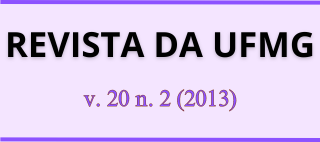In the beginning was the water
DOI:
https://doi.org/10.35699/2316-770X.2013.2689Keywords:
Babylonian cosmogonies, Hebrew cosmogony, Greek cosmogoniesAbstract
This paper discusses the Babylonian cosmogony establishing water as the beginning of everything, as well as Greek and Hebrew traditions dependent on them. In the poem entitled Enuma Elish , probably written in the 12th century BC, Apsû and Tiamat – spring water and seawater – are presented as the first gods, from which the orld takes its origin. It is noteworthy how, coming from people who live in the desert, these myths emphasize the character of water as a source of life, while working out an image of the sea as a dangerous force that is to be contained within its limits, task for the youngest of the gods, responsible for world order.Downloads
References
A BÍBLIA de Jerusalém. São Paulo: Paulinas, 1985.AGUSTÍN, S. Las confesiones. Edición crítica e anotada por Angel Custodio Vega. Madrid: Biblioteca de Autores Cristianos, 1974.
ARISTÓTELES. Metaf ísica. Edición trilingüe por Valentín García Yebra. Madrid: Gredos, 1982.
BOTTÉRO, J. Nascimento de Deus: a Bíblia e o historiador. Tradução de Rosa Freire D’Aguiar. São Paulo: Paz e Terra, 1993.
BOTTÉRO, J.; KRAMER, S. N. Lorsque les dieux faisaient l’homme: mythologie mésopotamienne. Paris: Gallimard, 1993.
CONNERY, C. There was no More Sea: the Supersession of the Ocean, from the Bible to Cyperspace. Journal of historical geography, v. 32, p. 494-511, 2006.
D’AGOSTINO, F. Gilgamesh o la conquista de la inmortalidad. Traducción de Francisco del Río Sánchez. Madrid: Trotta, 2007.
DAMASCIUS. Traité des premiers principes. Texte établi par Leendert Gerrit Westerink et traduit par Joseph Combès. Paris: Les Belles Lettres, 1991. v. 3.
ENUMA Elish: The Babylonian Epic of Creation. The Cuneiform Text by Wilfred G. Lambert and S. B. Parker. Oxford: Clarendon, 1966.
HÉSIODE. Théogonie, les travaux et les jours, le bouclier. Texte établi et traduit par Paul Mazon. Paris: Les Belles Lettres, 1982.
HESÍODO. Teogonia: a origem dos deuses. Estudo e tradução de Jaa Torrano. São Paulo: Iluminuras, 1991.
HOMER. The Iliad. Edited with an Introduction and Commentary by M. M. Willcock. London: St Martin’s Press, 1984.58. Para detalhamento de outros aspectos das informações transmitidas por Damáscio, ver TALON, 2001, p. 271-274.
KEE, M. S. A Study on the Dual Form of Mayim, Water. Jewish Bible Quartely, v. 40, n. 3, p. 183-189, 2012.
KELLY, A. ΑΨΟΡΡΟΟϒ ΩΚΕΑΝΟΙΟ: a babylonian reminiscence? The Classical Quartely, v. 57, n. 1, p. 280-282, 2007.
LABAT, R. et al. Les religions de Proche-Orient asiatique: textes babyloniens, ougaritiques, hittites. Paris: Fayard/Denoël, 1970.
LAMBERT, W. G. Berossus and Babylonian Eschatology. Iraq, v. 38, n. 2, p. 171-173, 1976.LAMBERT, W. G. Mesopotamian Creation Stories. In: GELLER, M. J.; SCHIPPER, M. (Ed.). Imagining creation. Leiden: Brill, 2008.
NOVUM Testamentum Graece. Ed. Barbara Aland, Kurt Aland, Joahannes Karavidopoulos, Carlo M. Martini, Bruce M. Metzger. 27. ed. Stuttgart: Deutsche Bibelgesellschaft, 1995.
PÉLICIER, Y. A origem. In: BRENOT, P. (Ed.). As origens. Tradução de José Carlos Almeida. Lisboa: Presença, 1991. p. 17-35.
PHILO OF ALEXANDRIA. On the Creation of the Cosmos According to Moses. Translation and commentary by David T. Runia. Leiden: Brill, 2001.
PHILON D’ALEXANDRIE. De opificio mundi. Introduction, traduction et notes par R. Arnaldez. Paris: Du Cerf, 1961.
SEPTUAGINTA id est Vestus Testamentum graece iuxta LXX interpretes. Ed. Alfred Rahlfs. 9. ed. Stuttgart: Deutsche Bibelstiftung, 1935.
SERI, A. The Fifty Names of Marduk on Enuma Elish. The Journal of the American Oriental Society, v. 126, n. 1, p. 507-519, 2006.
SERI, A. The Role of Creation in Enuma Elish. Journal of Ancient Near Eastern Religions, v. 12, p. 4-29, 2012.
SONIK, K. Bad King, False King, True King: Apsû and his Heirs. Journal of the American Oriental Society, v. 128, n. 4, p. 737-743, 2008.
SYLVA, D. The rising תורהנ of Psalm 93: Chaotic Order. Journal for the Study of the Old Testament, v. 36, n. 4, p. 471-482, 2012.
SYNCELLUS, G. Ecloga chronographica. Ed. A. A. Mosshammer. Leipzig: Teubner, 1984.
TALON, P. Enuma Elish and the Transmission of Babylonian Cosmology to the West. In: WHITING, R. M. (Ed.). Mythology and Mythologies: Methodological Approaches to Intercultural Influences (Procedings of the Second Annual Symposium of the Assyrian and Babylonian Intellectual Heritage Project). Helsinki: University of Helsinki Neo-Assyrian Text Corpus Project, 2001. p. 265-277.
THE STANDARD Babylonian Creation Myth Enuma Elish: Introduction, Cuneiform Text, Transliteration, and Sign List with a Translation and Glossary in French by Philippe Talon. Helsinki: University of Helsinki Neo-Assyrian Text Corpus Project, 2005.
TORAH Nevi’im vKtuvim. Israel: The United Bible Society, 1978.
TUGENDHAFT, A. Unsettling Sovereignty: Politics and Poetics in the Baal Cycle. Journal of the American Oriental Society, v. 132, n. 3, p. 367-384, 2012.
VAZ, A. S. A visão das origens em Génesis 2, 4b-3, 24: coerência temática e unidade literária. Lisboa: Edições Didaskalia, 1996.
WALCOT, P. Hesiod and the Near East. Cardiff: Wales University Press, 1966.
WEST, M. L. The East face of Helicon: West Asiatic Elements in Greek Poetry and Myth. Oxford: Clarendon, 1997.
WESTENHOLZ, J. G. In the Shadow of the Muses: a View of Akkadian Literature. The Journal of the American Oriental Society, v. 119, n. 1, p. 80-87, 1999.
YITZJAKI, S. El Pentateuco con el comentario de Rabí Shlomo Yitzjaki (Rashi). Traducción por Enrique Jaime Zadoff e Jaime Barilko. Buenos Aires: Yehuda, [s./d.].




